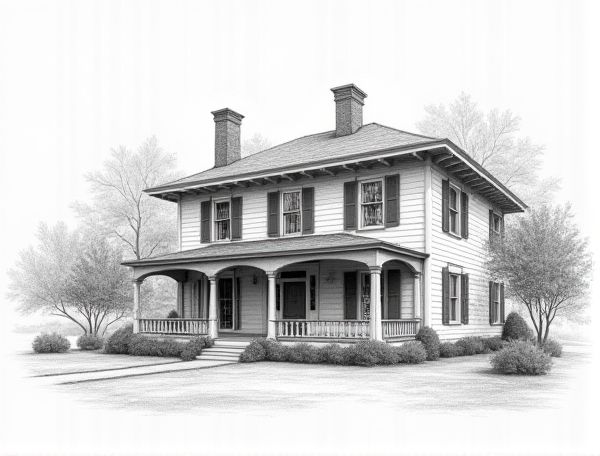
Photo illustration: Colonial revival home design with dentil crown molding
Colonial revival home design features classic architectural elements that evoke timeless elegance, with dentil crown molding adding refined detail and enhancing your interior's historical authenticity. Discover how incorporating this intricate molding can transform your space by reading more in the article.
Introduction to Colonial Revival Home Design
Colonial Revival home design features symmetrical facades, gabled roofs, and classical detailing inspired by early American colonial architecture. This style emphasizes a formal, balanced aesthetic with elements such as multi-paned, double-hung windows, decorative entryways, and prominent shutters.
Historical Roots of Colonial Revival Architecture
Colonial Revival architecture draws inspiration from early American colonial homes built in the 17th and 18th centuries, emphasizing symmetrical facades, gabled roofs, and classical details like columns and pediments. Understanding these historical roots can help you incorporate authentic design elements that reflect the elegance and simplicity of America's architectural heritage.
Defining Features of Colonial Revival Homes
Colonial Revival homes are characterized by symmetrical facades, accentuated front doors with decorative pediments, and multi-pane, double-hung windows often accompanied by shutters. You'll find their design rooted in early American architecture, featuring gabled roofs, dormers, and classical columns that create a timeless, elegant aesthetic.
The Role of Dentil Crown Molding in Colonial Design
Dentil crown molding enhances colonial design by adding intricate, evenly spaced square blocks that emphasize historical accuracy and architectural elegance. You can elevate your home's traditional aesthetic and create visual interest in ceilings and wall transitions with this timeless decorative element.
Materials Commonly Used for Dentil Molding
Dentil molding is typically crafted from wood, MDF (medium-density fiberboard), and polyurethane, each offering unique benefits for your home design. Wood provides a classic, natural appearance with easy customization, while MDF offers a cost-effective and smooth surface ideal for painting. Polyurethane is lightweight, resistant to moisture, and durable, making it perfect for both interior and exterior applications in your architectural detailing.
Incorporating Dentil Molding into Modern Interiors
Dentil molding enhances modern interiors by adding refined architectural detail that balances contemporary minimalism with classical elegance, creating visual interest along ceilings, cabinetry, and staircases. Incorporating dentil molding crafted from durable materials like polyurethane or MDF integrates seamlessly with sleek finishes, highlighting clean lines while preserving textural depth.
Color Schemes for Colonial Revival Homes
Colonial Revival homes often feature color schemes inspired by historical palettes, including muted shades of white, beige, and soft grays combined with classic navy blue or deep red accents to highlight architectural details. Incorporating natural wood tones and subtle pastel colors can enhance the traditional aesthetic while maintaining a warm and inviting atmosphere.
Exterior Detailing and Dentil Accents
Exterior detailing enhances a home's curb appeal through intricate design elements that highlight architectural style and craftsmanship. Dentil accents, characterized by small, evenly spaced rectangular blocks, add classic sophistication and depth to cornices, eaves, and moldings. Incorporating these details elevates the facade's visual interest and reinforces a timeless, elegant aesthetic.
Restoration Tips for Historic Colonial Revival Houses
Preserving the original architectural details in your historic Colonial Revival house, such as crown moldings, hardwood floors, and paneled doors, is essential to maintain its authenticity. Use gentle cleaning methods and historically accurate materials for repairs to prevent damage and preserve the home's character. Your restoration efforts should include updating electrical and plumbing systems discreetly to ensure modern functionality without compromising historic aesthetics.
Enhancing Curb Appeal with Colonial Dentil Molding
Colonial dentil molding adds a classic architectural detail that enhances curb appeal by creating a refined, timeless facade. Incorporating this decorative trim on eaves, cornices, and door surrounds elevates the visual interest and authenticity of traditional and modern colonial home designs.
 homedesy.com
homedesy.com